The macro photos (magnified images) in this section were captured with the Little BigShot Image Amplifier, which gives my little compact camera a good boost for closeups. Link to the product: Little BigShot.
My flora photos are generally not panoramic. I tend to focus upon individual flowers and their details using the style of capture known as photomicrography (camera as close-range microscope). The photos depict raw nature; meaning that the flora appear as they self-present in nature. I do not steady them, relocate them, nor dress the venue. And I do not enhance the photos with software, unless a minor brightness adjustment is required for internet visibility.
The Earliest of all Wildflowers . . . the Snowdrop!


While hiking Doanes Falls, I came across Lily of the Valley wildflowers. The corolla of this enchanting little flower very nearly resembles a white ceramic votive with scalloped and curled edges, while the pistil resembles a stout yellow candle and the style looks like a white wick; finally, the stamens look like green prongs holding the candle in place. The fuzzy white pyramid in the background is the first falls of the Doanes range, quite out of focus.




A few shots of the wildflower known as Fringed Polygala; a species, though native to New England, was a new find to me this year at age 53. Must be one of the regions best-kept botanical secrets.




Sometimes, even blue flowers get the blues.

The common name of the wildflower is Persian Speedwell (Veronica Persica)

The last of the American Bittersweet berries put on a good show for me today.
This berry is surrounded by peers in the background.

Solitary berry with fallen leaves as a background.

This couple has decided to undress backwards.

Sometimes, it's just so hard to let go.
 Oooops, I seem to have lost something.
Oooops, I seem to have lost something.Cut Down in the Prime of Life!
I chanced upon a Jack-in-the-Pulpit which had been trampled or torn by an animal, and it afforded me the ability to explore the hidden design features of this plant without damaging a healthy specimen.

When we magnify the severed Spadix, we find a plurality of tubular cells and baffles. Notice also the color scheme of green and maroon, which is consistent throughout this curious plant.

Peeling away the sheathe, we find that the spadix becomes a more solid maroon, then suddenly transitions to lime green before narrowing for a short distance in the green and maroon striped scheme, and the base consists of a most unusual white globular section, hosting back seeds.

A closer look at the lumpy white part of this peculiar plant.

Peeling away what remains of the sheathe, we find another surprise; at the base of the seed shaft, there is a spattering of maroon dots. This shot also nicely shows the groves and maroon color pattern of the stalk.

Despite the malicious shredding of the plant, I close this series on an upbeat note, showing a healthy and handsome Jack.
He is handsome, wouldn't you agree? All those stripes and swirls and that erect, conspicuous spadix standing tall in the midst.

I'd call him dashing and debonair. Which insect could possibly resist!

Now, if you have trouble spotting Jack-in-the-pulpits . . . you're not alone. This plant grows low to the ground and viewed from above while walking, it is hidden by its curled over sheathe, which looks like a curled leaf.
This photo will help. These are the basal leaves of the plant. If you look just to the left of them, you will notice the curled sheathe. Kneel down, and there's Jack!

Wild Columbine as a toddler.

As a teenager.

As a young adult.

Wild Raspberry closeup.

Wild raspberries . . . in several flavors.

Every now and again, the common red clover is uncommonly beautiful.

Chicory wildflowers are now in bloom. :)

The Land of Indigo Curliques.

Interesting spherical floral being in passed phase.

A much closer look at this little ball of wonder.

I've been in search of the perfect milkweed seed. This is close!

She's such the swirly girl.

I found these to be rather unique Autumn colors.

This fern frond is shriveling in a most dramatic fashion!

A rather handsome two-tone blade of Autumn grass.


As beautiful in passing as in bloom.

Is this not a most handsomely marked fern frond?

Such a glossy shade of charcoal.

Some frosty flora photomicrographs.






She was a vibrant sunflower only 3 scant weeks earlier.

American Bittersweet berry, open, with a tiny raindrop resting upon its arc.

I met a gorgeous wildflower during my morning walk, so I shot a brief PhotoChronicle when my walk was complete.
The flower begins as a globular green bud with burgundy seams. Notice also the secondary sepals beneath the bud, a ring of ornamental prongs.

And here is our full bloom flower, with 5 interleaved white petals hosting a bushel of yellow stamens and red stigmas set in a vortex of deep burgundy. Another interesting design feature of this flower can be seen in the petals. Where the burgundy meets the white, the burgundy wicks up the seams of the white region of the petals, but is not permitted to travel far, creating the appearance of a burgundy crown against a white background.

In the side view, we see the extent of the beauty of the full bloom wildflower, the sepals, secondary sepals and petals all merging into an artistic symphony. The sepals, which begin as opaque green, become translucent and the hues and shadows of the petals can now be seen through them.

To further emphasize the beauty of this sepal translucency, a more magnified version of the view.

Finally, a close range magnification of the reproductive cluster. The yellow stamens are shown to be comprised of tiny beads; whereas the pistil is a style which branches out to host 5 furry red stigmas. Simply a marvelously designed being of nature.


Forget-Me-Not wildflowers.

Blossoms from an unknown shrub. If you look closely at the corolla, you can see that when the petals split and peel, their peeling is restricted by ribbed reinforcement, beyond which the peeling action can't advance.

Wild Morning Glory (hedge bindweed)

Time for some images of the fascinating Milkweed blossom.








Before getting into the azaleas, a few pictures of other things found at Moore. I was delighted to find the increasingly rare orchid we call Pink Lady Slipper. These were once abundant in New England. That is no longer the case, However, the term "abundant" is relative. Lady Slipper is not a "patch" wildflower, rather a bit of a loner, and when they were abundant, you would find one flower every 10 yards or so. These days, it seems more like one flower every 1/4 mile. Sad.


And, blueberry blossoms were everywhere; both high bush and low bush.


These little pinwheel-shaped wildflowers were everywhere, dotting the forest floor.

I was about 10 days too early for the Mountain Laurel, and unable to stay in town long enough for those amazing wildflowers to bloom, but here's a tiny bud.

Finally . . . the azaleas. They appear in every color and shade one could imagine. And they are densely populated. The entire place literally bursts with color.



I like the way the sunlight plays upon this corolla.

And I like the way the back light reveals the petal patterns.

Just as no two humans have identical finger prints, after analyzing the petal patterns of hundreds of azaleas, I suspect the same is true for them.

Common but beautiful. What is it? The red clover blossom.

A rather frilly, elegant seed pod from an unknown wildflower.

When we pause to consider the intricate structures of the things found in nature, then the simple leaf isn't so simple after all.

Late Summer wildflowers tend to be much smaller than their early-season counterparts, but this doesn't necessarily mean they lack beauty; as can be seen here in this bouquet of unapologetic pink profuseness erupting from a rich red center.

I found this wildflower next to a dry stream bed. The common name is Tall Bellflower. The plant is a design masterpiece with (5) margined petals of purple, a pointed pentagonal pistil hub from which emerges a protrusive, curved style, crowned with a tri-split tip. The bases of the petals and the external walls of the pistil hub in white, form the appearance of a ring around a bulls eye, and the sepals reflex dramatically. This plant is intriguing from any angle viewed. The next photo better reveals the most curious feature of this flower.
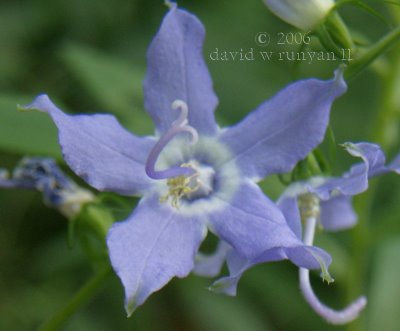
At the juncture where the style emerges from the pistil, there are twisty, curly tan ribbons dangling downward, like Christmas gift wrap ribbon, to which a woman might add extra curl by passing it along a scissors blade.

Just look at this stunning wildflower! Virgin white nodding blossoms, and from this angle, they are gorgeous, but wait until we look into these bowl-shaped corollas. And they call it Lily of the Valley.

Is this not unbelievable? The pistil looks like a yellow candle, and the style looks like a wick. The stamens are prongs retaining the candle, and the entire ensemble is set inside a white china votive with scalloped edges!

Wild Prairie Trillium, A Mini Chronicle
I followed the development of the Wild Prairie Trillium this year. This flower is not at all like the trillium with which I am familiar in New England with their large, conspicuous, laterally growing petals. But in its own right, this plant is fascinating and visually exciting.
Here it is in the early phases; its broad basal leaves in two shades of subdued blueish green. The small member in the center is the floral bud, which eventually becomes 3 rich red petals which grow vertically and curl sensually inward toward each other at the top, to form a sparkling maroon tee pee with openings through which the marvelous reproductive cluster may be viewed.

When we examine the bud, we find a green member with noticeable veins and a rather hard tactile appearance.
No one would guess how sweetly soft and sensual they become.

And THIS is what those hard green parts become . . . deep red, shiny, sensually curved petals!
What a transformation! What a surprise! And look at the wonderful way the sepals cling to the calyx as they flair downward away from the blossom!
As I previously stated, not the conspicuous flower we find in New England, but astounding nonetheless.

And here's a closeup of the petals. Such rich color, such sweeping sensual shapes, and whisper veins just slightly deeper in hue than the petals themselves.

A closer look at the reproductive cluster. The petals are spaced in such a way that they permit partial viewing of the sexual elements of the wildflower.
The stamens are dense, leathery flat rods curling in toward each other (like the petals do) and meeting at the top (like the petals do), forming a birdcage structure around the pistil with opening for a partial view (as the petals do).
Is this not an amazing wildflower?

This is my favorite image of the Wild Prairie Trillium. There is a softness to it which I find appealing. A divine light at the base of the photo, an artistic blur to the petal tips and sweet bokeh elsewhere.
No, it's not the New England Trillium which graces our mountainous forests . . . but it captured my fondness effortlessly.

The Mayapple Wildflower Chronicle
This is one of nature's wondrously curious plants called Mayapple Wildflower.
It pops up from the ground in very early Spring; being among the seasonal pioneers and a herald to the end of winter.
As you can see, it has spirally wrapped spinach-like leaves, held in place by a pearl-white sheathe.

And here is the mature Mayapple wildflower; a rather exotic looking leafy plant, leaving one to ask . . . where is the wildflower?

And here is the blossom! Hiding under the shade of the expansive basal leaves, about half way up the stalk.
These blossoms are easy to miss. Here's a hint to help you . . . double-stalked plants always have a blossom; single-stalked plants never do. Another hint; it takes 3-4 weeks from the time they pop up until the blossom opens. Last hint . . . unless you're low to the ground . . . these will evade you.
Let's have a closer look, shall we?

What a grand piece of luck! The blossom had sunlight behind it; nicely illuminating the dense petals.
Let's have an even closer look . . . shall we?

The reproductive cluster is a series of hearty, thick stamens surrounding a hard, nut-like pistil with a strange coagulation of crystalline substance at the top which I assume is the stigma(s).
A strange and wonderful plant from start to finish, from head to toe this Mayapple is.
And if you Google it, you'll discover interesting facts about the medicinal usages of the plant as well as its extreme toxicity.
 Here is a photomicrograph of tree gall. As you can see, it is generally cylindrical with vent holes; suggesting a cocoon of some sort, and by virtue of these suppositions, one would also assume the structure to have thin walls and to be hollow.
Here is a photomicrograph of tree gall. As you can see, it is generally cylindrical with vent holes; suggesting a cocoon of some sort, and by virtue of these suppositions, one would also assume the structure to have thin walls and to be hollow.
I took a sample home, and in this photomicrograph, we see a healthy stem, terminating in a bud.

In this photomicrograph, we can clearly see that the structure is a growth from the sides of the stem which bends the stem into a curve, and even the bud at the end of the stem is clearly seen. So, this is a tree gall and not a cocoon or shelter constructed by an insect and attached to the shrub.

I snapped the structure in half. It has the feel and hardness of wood. And as we can clearly see, the structure is solid, which means that in no case is there room for an insect to maneuver or breathe inside the growth. Furthermore, the circular apertures are shallow, superficial features and do not serve to create any vent system to the inside of the structure.

Antique White Reeds
I found a narrow path, and along the way, this cluster of reeds with antique white seed heads came into view. I hadn't seen this species before and found it attractive. Most reeds have shiny, light green seed heads which turn tan or brown in Autumn so this species piqued my curiosity. The small red maple in the background was a nice contrast.

A close up of the seed head, which is called the inflorescence. A rather elegant nodding brush of floral fibers which waves to you gently with the slightest breeze.

A photomicrograph of the spikelets. As we can see from this shot, the "whiteness" is derived from the silky fibers surrounding the tan spikelets.

I found a small patch of these nodding purple wildflowers in only one place in the forest. Rare in that the sepals are burgundy. Sepals are usually green.
 As the wildflower blooms, the calyx becomes elongated, and apparently, much of the burgundy pigmentation diminishes with the growth. The petals also, are a lighter hue of lavender as the corolla begins to fan out.
As the wildflower blooms, the calyx becomes elongated, and apparently, much of the burgundy pigmentation diminishes with the growth. The petals also, are a lighter hue of lavender as the corolla begins to fan out.
And from this angle on a full bloom flower, we see, among other things, a long style with a split stigma. I constantly marvel at the visual appeal and artistic merit of wildflowers as they present unrehearsed in raw nature.

From another angle, we see that the stigma is tri-split. The stamens seem to be of two types: color and length marking the distinctions.

The case of the orange berries which are neither orange nor berries.
There is a shrub, common in New England, which, to the casual observer, seems to yield bushels of what appear to be orange berries, but upon close examination, the orange part is not a berry because we see seams (margins) which are beginning to split and berries of course, do not split. The common name for this shrub is American Bittersweet and the scientific name is Celastrus Scandens.

In this photo, we more clearly see that the orange part is simply a shell, housing what we now assume to be a red berry.

In this photo, we see that the orange parts are sepals which split and reflex, to expose the red part which we still assume to be a berry. But upon tactile examination, this red sphere is hard and non-juicy. It is in fact, a red nut and not a berry at all. Who said nature has no sense of humor? This plant first misleads you to believe that it hosts orange berries, then further misleads you to believe it yields red berries; all the while producing a nut which doesn't look like a nut at all. Nature, at times, is a practical joker.

These curled dry leaves just looked so nice to me, I needed to shoot them. It was a compulsion. And isn't it remarkable how you could snap them off their stems so easily, but they just as easily withstand the cold and wind and heavy snows of 4 months of winter!

About 1/3 of the goldenrod stalks hosted gall such as this.

Speaking of goldenrod, here's a rather picturesque specimen.

The explorer's formidable foe!

Cute little white tips . . . lots of them.

Now here's a fascinating plant design. The blossoms (and now the seed heads) bloom from only one side of the stalk.

And a close in shot of this fascinating plant.

Looks like he succumbed, but wait! If you notice, there's melting going on in the shape of the plant; which means of course that the plant is creating warmth, so it yet lives! It would be interesting to see if this plant springs back to vertical living in April. Unfortunately, I won't be here to find out.

Very frilly, pleated seed heads.

There is design wonder, if not artistic beauty, in the passed phase of wildflowers. In the case of this particular species, both are glaringly obvious.

Thou shalt not touch! lol The bull thistle, painful from base to tip, until it blooms with velvety soft purple fibers.

What a curios wildflower this is; a multi-tier ray floret in petals of soft pink. A delicate and beautiful thing, growing by itself and unassisted in the midst of harsh wilderness. People who grow cultured flowers nurture them at great expense, yet achieve less success than does untended nature. As a believer in a Creator, it's easy for me to accept that He designed survival and success into His self-sufficient gardens. As a mechanical engineer, I have difficulty reconciling the defiance of species to the scientific laws of entropy and atrophy; there being no degeneration of any species over any observable length of time. While each individual being (humans included) serve out their linear cycle of birth-to-death, the species itself remains unaffected by scientific laws pertinent to systems as a whole.

Now this wildflower is going to surprise you. A dried, brown membranous element protrudes from a bowl-shaped sepal system, and since the protruding part seems withered, I assumed that this plant was in passed phase.

But upon closer examination, we find that inside the sepal bowl is a virile, deep green bud. Notice how the dried part is tethered to the bud.

And just look what bursts forth from that green bud! A surprising and ornate array of spade-shaped white petals and a host of wiry string-like stamens! And no sign of the dried membrane. Is this not a most surprising flower?
 This has simply got to be the largest leaf I have ever seen in my entire life. Even larger than skunk cabbage leaves. . . by miles. So large that tree debris collect in the center. And notice the peculiar white veined patterns. Natural graffiti?
This has simply got to be the largest leaf I have ever seen in my entire life. Even larger than skunk cabbage leaves. . . by miles. So large that tree debris collect in the center. And notice the peculiar white veined patterns. Natural graffiti?
A developmental chronology of the Wild Geranium.
Early bloom phase.

Mid-bloom phase.

Another mid-bloom photo.

Full bloom phase.

And lastly, my all time favorite Wild Geranium photo. This pair simply looks so elegantly artistic! And a baby geranium is nestled between them.

This is a nut, about the size of a large acorn, which the host tree presents in a highly ornate wrapper of frilly edges, silky fuzz and brown freckles.

If you've ever wondered what remains once a wild raspberry has been eaten . . . you needn't wonder any longer.

I noticed the wildflower I call Cherry Drops. This plant grows on a slender stem about 2' high and hosts dozens of these magenta blossoms whorled on the stalk. The blossoms are miniature, perhaps 1/10th inch long. An unusual species since they seem to have no petals; only magenta sepals which remain tightly closed, housing a white pistil from which extends a white style with a forked stigma. This plant heralds the end of summer.

A close up.

The Lavender Milkweed may be the only plant whose petals and sepals swap colors during growth. Notice in this photo of early bud phase, that the sepals are cranberry and the petals are green.

As the plant develops, the petals become cranberry while the sepals become green. Isn't this utterly fascinating!

Here is a pioneer blossom, all alone and fully mature in the middle of a bunch of unopened buds. What we see here is that the petals peel open and reflex downward to expose the very creamy, waxy light lavendar stamens.
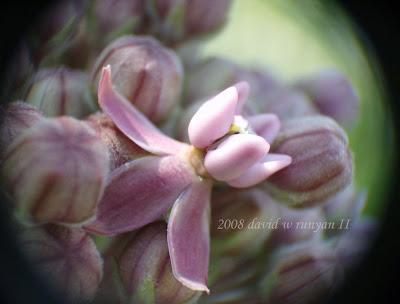
Let's view another angle of this pioneer, looking straight down into it's intriguing corolla. Is this not a most bewildering plant? It is geometry florafied. The pistil is a pentagonal hub hosting a slit in the formation of a 5-point star on its surface, and notice the black stripes on the sides of the pistil which align to the slit star points. The stamens are a semi-circular cone of creamy, waxy texture, from which emerge claws, the stamen ensemble being aligned with the points of the pistil and interstitial with the slit star on the surface. An absolutely stunning design. Shall we have a closer look? This view is 10x.

20x

40x

60x (close enough?)

Finally, here is one of the spherical bundles of blossoms in full bloom phase. Just wait til Autumn . . . you won't believe the fruit this plant produces.

This is the pink version of the curious milkweed plant. It blooms much later in the season than does its relative, the lavender milkweed plant. While similarities abound, such as the pentagonal design aspects of the separate components, there are stark differences in their respective stems, stalks, leaves and reflexive sepals.

Most notably, the pre-bloom stage of the lavender is a fuzzy, cranberry colored bud, whereas the pink version hosts a smooth, fleshy, pink bud which looks like the small bells one might find on a cat or dog collar.

This small white wildflower hosts a totally exposed pistil of waxy white, and golden anthers. These seem to grow in small clusters of 3 - 5.

except for this loner which I found some distance away from the others.
 This little flower , despite its size, is bursting with stamens.
This little flower , despite its size, is bursting with stamens. The wild Daffodil. Such a large siren for the beginning of Spring.
The wild Daffodil. Such a large siren for the beginning of Spring.
Another interesting aspect to the flower is its growth mechanism. As you can see from this partially bloomed plant, it is erect during that phase.

But as you can see from this mature plant, it becomes a nodding flower when in full bloom.

This wildflower is a visual illusion of sorts. Dependent upon how you shift your eyes, either the fan-blade petals or pointed-star sepals come to the forefront of attention.

Buttercup beginning to bloom. I found this shot highly artistic.

Attractive ground rose in partial bloom phase.

The petal apertures of this wildflower expose the sepals beneath in such a way that the sepals seem to be an ornate green star blended into the petal system.

A rather unusual, vase shaped tree blossom with no petals whatsoever. The sepals peel away to reveal the tangled array of stamens and string filaments. Very pretty though.

The Orange Jewelweed. Quite common but still quite attractive.
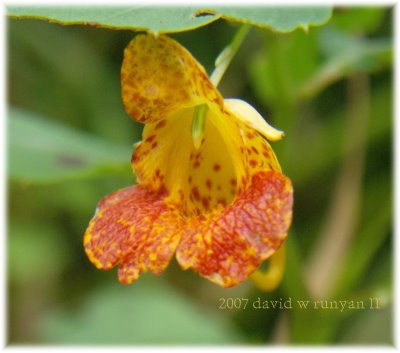
While hiking in the Pittsburgh area, I discovered this yellow version of the Jewelweed; identical in every way except coloration and markings . . . it also has the pigtail. Curiously, with all the exploring I have done, this yellow version has been found nowhere except in the Pittsburgh area.
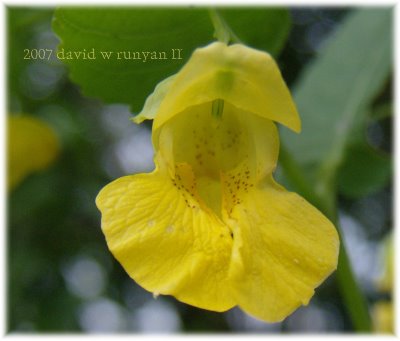
Side view of the Orange Jewelweed . . . note the curled pigtail.

Side view of the Yellow Jewelweed. Unfortunately, not a good shot of the pigtail, but it is the same configuration as the orange.
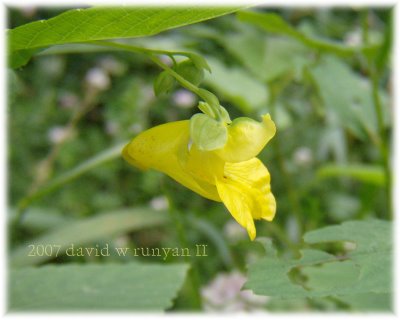
These late-spring tree blossoms, with their blend of magenta-white petals, have the textural appearance of crepe paper.

In this shot, we can see that that the flowers grow in pairs, called couplets.

This tree blossom is probably distantly related to the magenta blossom above. The petals and stamens all appear distinctly different. There is a similarity to the stigma, but notice how strongly the couplet calyx resembles the other.

This is the Virginia Waterleaf. Notice that in pre-bloom phase, the petals are white.

Now notice that the petals transition to lavender. This is the only wildflower I've ever encountered which does this. All others begin as deep hues and transition to lighter hues or white with growth. This flower starts as white and develops hue as it grows.

This is a funny plant. I call it Bad Hair Day. It looks like a box of ziti pasta after a firecracker was thrown inside. It's common name is Prickly Lettuce.

This plant, which is called Mayapple, is going to surprise you. A grassy plant; prior to bloom. Take note of the fact that there are two distinct bundles of leaves, that the leaves are wide, and that there exists a pale green bulbous member between the two bundles. You simply won't believe the growth mechanism of these three distinct members.

THIS is what those 3 distinct members become! A unified whole! The wide leaves become narrow blades, the two separate bundles fuse seamlessly into one array, and the unified array fuses with the bulbous member which then becomes the center of the floral whole. Simply amazing! The plant produces a single flower which develops into a fruit (the apple), but all parts of this plant are toxic except the fruit. It has several medicinal uses, most notably as a treatment for genital warts and skin cancer.

The Everlasting Pea is conspicuous both for size and color vibrancy.

. . . and a closer look.

This is the wildflower called Spring Beauty. And a beauty it is! I am unaware of any other plants with lavender petals and magenta anthers! Alone in its color class of soft pastels.
 From this angle, we see how frail a stem this plant has, and how the sepals are fused into the shape of a bowl, supporting the flower at all points of its corolla.
From this angle, we see how frail a stem this plant has, and how the sepals are fused into the shape of a bowl, supporting the flower at all points of its corolla.
. . . and a couple of Spring Beauties from 2008.


This wildflower is color-contrast-coordinate amazing. The various parts cover the entire spectrum of lavender, pink and blue in their pastel hues; including the anthers which are pale azure blue. It is called Viper's Bugloss.

. . . and a closer look.

An all-around intriguing design. Needle point tipped petals in medium blue with dark blue stripe veins, a yellow-green vortex in floral pattern and a golden yellow rectangular stigma. They call this Pointed Blue-Eyed Grass, for what reason, no one knows. The "eye" is yellow and it's not in the grass family; it's in the iris family.

This grassy plant was so beautiful, I felt I should classify it a wildflower. Not often a leafy plant like this is a color other than a shade of green.

The pre-bloom leaves look like lobster claws.

This is the wildflower they call Orange Hawkweed or Devil's Paintbrush. We see pre-bloom petals of rich color. Most wildflower petals fade to lighter hues as they bloom, but as we shall see in the next photo, such is not the case with this particular flower.

see?

This is a most curious tree. Its fruit are these maple-key-like pods arranged much the same as the wildflower known as Dutchman's Breeches. This is a low-growing shrub with enormous leaves contrasted by its bursting abundance of pale green fruits.

The pods just dangle downward from these attractive, pale green stems, spotted every quarter inch or so with medium brown bracts.

60X photomicrograph of the fruit. A slender stem becoming a textured translucent teardrop, housing a brown nut-like element.

The mint called Obedient Plant. What a total surprise it was to come across this gorgeous, delicate wildflower in the deep woods where one normally finds no flowers at all! It grows on a stalk 2-3' high in a radially whorled array. The pre-bloom buds are purpled marbled. The blossoms are purple veined with 4 deep purple anthers hovering above medium purple leopard dots. In addition to being beautiful, this plant must also be rare. In 3 years of hiking this particular forest, this is the first time I have encountered this plant. Altogether an exhilarating find.

A very unusual maple leaf comprised of 5 toothed lobes. I believe that botanists call this configuration palmately toothed.

The fascinating Moth Mullein. It grows on a stalk 2 - 4 feet high, the buds are a deep red, heart-shaped formation, nestled in already-open sepals, forming a perfect 5-point star, and the entire plant, stalk, sepals, buds, is covered in silverish "goosebumps" . As if the pre-bloom plant was not sufficiently fascinating, the blossoms are equal on the comparative scale of captivation and curiosity.

The entire ensemble of pistil/stamens is surrounded by bushy fur, which near the petals is red, then transitions to a medium shade of purple, and at the tips is a light shade of purple. The stamen filaments are deep green with anthers in the shape of composite crescents; being lime green fused to bright orange. The style is black and the stigma is emerald green.

An overview of the plant depicts that the blossoms are radially whorled, and when the plant is in full bloom, one can imagine a cylinder of dense beauty and spiralling wonder.

This is the plant called Common Mullein, and there seem to be few if any similarities with Moth Mullein apart from the blossoms being radially whorled on the stalk. But this plant is wolly to the touch everywhere: basal leaves, sepals, petals, stalk.

The 60x micrograph reveals just how fuzzy a plant this is.

Wild Forget-Me-Nots

Next up is the Foxglove Beardtongue, thusly named for the long sterile stamen, which protrudes further than other elements of the flower and is covered in spiky hairs. One notices also how the style curls downward toward this hairy element.
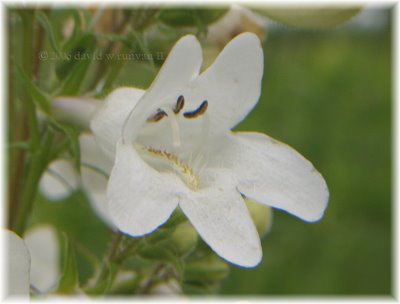
From this angle, we can see that the stamen filaments swirl around inside the flower, creating what appears as a rib cage against the inner wall of the corolla.
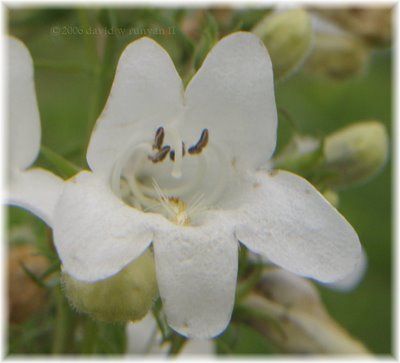
The midwestern wild rose as a bud.

. . . as a young blossom.

. . . as a mature plant in its habitat, surrounded by the unborn, the passed, and deep lush greenery.
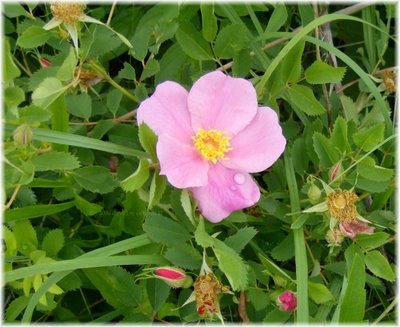
The New England Wild Rose tends to be lavendar, but also presents as pink on occasion.

The New England White Birch. She stands so elegant in a denuded winter forest. Why is she here among the wildflowers? Because a tree is simply a large flower, and also because I like her; she is one of New England's incidental dialectics, and one of the many things about home which I miss while away.

This is what they call the Bell Flower or Blue Bell.

This tree blossom grows in clusters of 8-10, has 5 virgin white, cottony petals, 5 faint green styles and a host of stamens.

And here's what the clusters look like prior to bloom . . . in my estimate, as attractive as the blossoms. If you enlarge this photo (click in the center), then you will notice that the sepals are tipped in red. This could easily become one of my all-time favorite flora-photos.

Another tree blossom . . . frilly . . . feminine.

This is the Prairie Trillium. It is unlike the trillium of New England in that it's petals grow vertical and inward toward each other to form a tee pee. New England Trillium petals grow laterally outward and assume a much more predominant presence over their basal leaves. Nevertheless, an attractive plant.

Here's a strange little wildflower. Each plant hosts approximately 20 buds; 25% of which are of this exotic design and appear to be non-flowering. The side view.
 The top view.
The top view. The remaining bouquets are flowering buds in various stages of bloom. Early blook phase.
The remaining bouquets are flowering buds in various stages of bloom. Early blook phase. Full bloom phase. In this shot, please notice the very ornate elongated apertures between the petals, from which the color of the sepals exudes nicely, and also notice the pistils and stamens of varying colors which have the appearance of salt & pepper corn.
Full bloom phase. In this shot, please notice the very ornate elongated apertures between the petals, from which the color of the sepals exudes nicely, and also notice the pistils and stamens of varying colors which have the appearance of salt & pepper corn.
Blue Flag (wild iris)

The most perfect Blue Flag I ever met! This plant grew straight up from the water at our wilderness fishing spot.

Yellow Flag (wild iris)

Snapdragon of some sort. It was exciting to find this flower. It was one-of-a-kind in that particular forest. I diligently searched the entire place for another and found none; no buds, no early blooms, just this solitary representative of his species in an 80-acre forest.

These flowers were so attention-grabbing with their sky blue petals and inner white bulls eye circling a hexagonal, pleated, pistil enclosure.

From the side we see that they aren't only without stamens, but also lack sepals.

These tree blossoms appear to be in the Rhododendron or Azalea families. In addition to the magenta striping of the petals (which always stands out in a green forest) the anthers are bold and robust. The most curious design feature of course is the way the stigmas rest upon the lower petals.
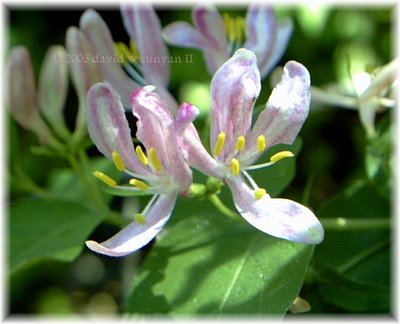
I found these berries while examining bindweed buds. They grow low to the ground, only 3" at the highest, bear a strong resemblance to strawberries for texture, but not for shape. It is however, the Wild Strawberry, and it is edible.

A very strange plant this is. It grows on a thin stalk, and the beige/maroon spheres at the top, which are as hard as thick plastic, have sufficient weight to cause the plant to list at greater than a 50 degree angle. From the spheres bloom a light lavender, waxy corolla of an exotic design.

the corolla at 60x.

Dame's Rockets These flowers are common and abundant, but their prevalence does nothing to detract from their fascination factor for two reasons: first, while hiking thru a predominantly green, early or mid Spring forest, these flowers suddenly and vibrantly appear in vast clusters, at times covering a half acre of forest . . . secondly, in coloration, streaks, stripes, swirls, fades and blends, these flowers are not governed by any rules . . . it is impossible to find any two alike . . . the color and pattern combinations are endless.

I happened to catch a purple bud surrounded by mature white Dames Rockets and thought the vision was lovely and artistic.
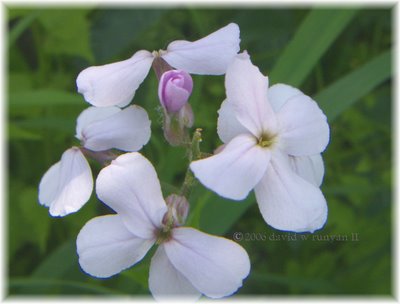
The Wild Day Lily. This flower seems to spring up suddenly and sporadically, is noticeable from great distances and always a pleasure to behold. It is similar to the wild iris in size and color contrast to its surroundings so its visual stimulation factor is high.
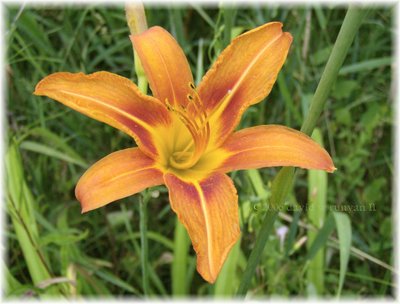
Quite the case of pistilus erectus going on here :)
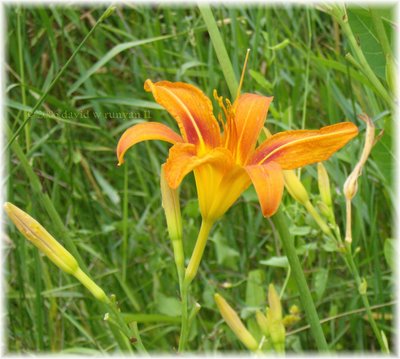
another rather brilliant day lily springing up by itself in the thick of green things.

Crown Vetch, with its radial array of alternating white and lavender petals and its hollow corolla devoid of pistil and stamens is nonetheless a very colorful and beautiful ground cover which remains in bloom for much of the summer and seems drought resistant. It doesn't pass as swiftly as most wildflowers.

Birdsfoot Trefoil is very siliar to Vetch in that it presents its petal array radially and its hollow corolla is likewise devoid of pistil and stamens. Also like the crown vetch, it remains in bloom for most of the summer and seems more tolerant of drought conditions than other wildflowers.
 just a common daisy, but, its presentation in nature i found artistic; a solitary flower, standing proud and alone to grace a vacant spot of the forest.
just a common daisy, but, its presentation in nature i found artistic; a solitary flower, standing proud and alone to grace a vacant spot of the forest.
Daisy in full bloom phase.
 yup! the best of time of year weatherwise is about to have its advent, as evidenced by these grasses ahead of the tall reeds.
yup! the best of time of year weatherwise is about to have its advent, as evidenced by these grasses ahead of the tall reeds.
most things in nature have perceptible geometry. in the case of this berry, there are three, equidistant dark margins and precisely at the half way point of each is a lighter margin. the berry is a lobed sphere. the dark margins occur at the cleavage between lobes and the lighter margins disect the lobes at the center of the rises.

I was quite spellbound by these flowers. The petals with varying light to medium blue hues behind the deep indigo anthers caused them to take on a stark 3-D appearance.

The Hedge Bindweed! aka Wild Morning Glory! I caught this one half open at 7 AM.
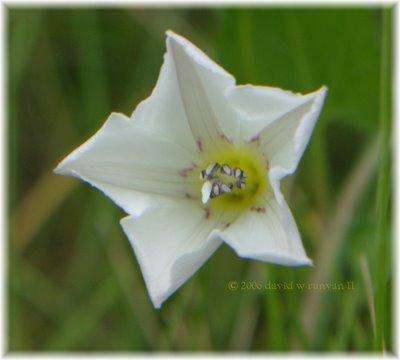
The bindweed in all it's morning glory in its habitat; interspersing the sea of green with it's siren of contrasting shapes and colors.

Hedge Bindweed, nestled deep in the grasses and with a recent raindrop caught on it's curling petal. Incidentally, this shot is not at an angle. So why the raindrop doesn't simply roll off is a mystery; it rests at nearly an 80 degree angle.

I get downright excited about plants which surprise me and this one does. The stalk grows to about 3 feet, and at the top is a cache of buds in a tissue-like wrapper. Eventually, one of the buds "hatches" out of the cache, it's stem shoots another 3" and the flower blooms. The remaining buds follow suit and the plant becomes a full display of 8 - 12 blossoms. It is named Wild Garlic, it is an onion plant in the lily family.

It's growth mechanism isn't the only fascination. It's design and coloration attributes are quite interesting as well. The petals are pale pink, the stamen filaments transition from white to lavender, the pistil is a rich green nodule from which emerges a translucent white style.

The wildflower they call Yellow Goatsbeard, and while the yellow makes perfect sense, I searched the internet for photos of goat's beards and for the life of me, I fail to see the connection.
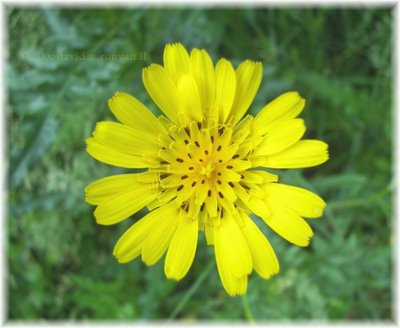
The enchanting Trout Lily which proliferates in early Spring. The petals of this inverted wildflower defy gravity and reflex robustly upward.
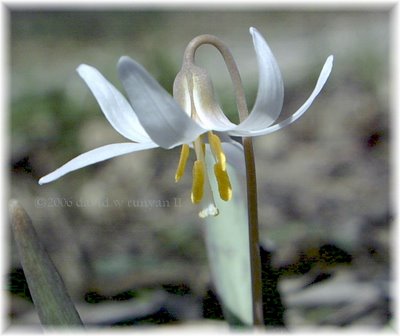
When i saw this scene, I had to shoot it! The little wild rose bud looks like it's suspended on air above the cupped hands of it's sepals.
 These tiny, fuzzy, dotted plants named Henbit (mint family) bear resemblance to both Ground Ivy (also mint) and Self Heal (not mint).
These tiny, fuzzy, dotted plants named Henbit (mint family) bear resemblance to both Ground Ivy (also mint) and Self Heal (not mint).
The White Campion. What a funny looking little plant! The watermelon-like calyx is hollow. . . all that bulbosity for nothing! :)

The pistils and stamens emerge from the tight hole in the center of the corolla and curl around to the petals to form the visage of a rivet.

The term which comes to mind about the Wild Hyacinth is "flagrant". Its pistils, styles and stamens stick right out there while the petals fold back a bit to allow unimpeded presentation. The plant grows in whorled array densely and profusely on a 3 foot stem, and the species is so populous that the forest floor seems snow-covered during the cycle of this plant. Think I jest? Look at the next photo.

See? I wasn't kidding.

This is Jimson Weed. An attractive , ornate wildflower, but all parts of it are poisonous: stem, leaves, sepals, petals.


The seemingly uneventful Self Heal plant. This plant grows only 6" high and this is what it looks like to a person walking past as he glances downward. If you don't lie on the ground (because none of us uproot wildflowers, do we?) to view the blossoms from their undersides, you would go about your life assuming this to be a rather bland little weed . . . but

Surprise surprise! The upper lip has two fine antennae and hosts the plant's sex organs, the lower lip looks like a fringed tongue, complete with a groove (margin) running down the middle, and the tiny flowers almost look as though they are laughing at you (probably because you are lying on the ground)

Who says white flowers are boring? This Star of Bethlehem is both an attractive wildflower and is endowed with several interesting structural details. From this view, we see a golden pistil surrounded by 3 petal shaped stamens forming a star. But wait for the angled view . . . . .

The 3-point star is actually a 6-prong crown with the wider 3 prongs reflexing outward while the more narrow prongs remain erect.

From below, we see that the sepals are fused to the petals, and this is one case where the bud and the bloom resemble each other.

The Multiflora Rose as a bud.

Ahhh the benefits of hiking during a rain! An artistic photo such as this can be captured no other way.

Multiflora Rose in full bloom. I trust you can see how the "multi" was derived.
 This is the Multiflora Rose blossom fresh and new.
This is the Multiflora Rose blossom fresh and new.
And this is the Multiflora Rose blossom preparing to enter passed phase.

The Mountain Laurel is almost too fascinating to ponder. The petals have sockets to retain the anthers; the anthers, emerging in a tangled bundle from the vortex, remain embedded into the petal sockets, yet with the slightest, gentlest touch, they pop out instantly. Other interesting aspects of this wildflower are the deep red ridge at the kneewall of the corolla, the pistil style, identical to the stamen filaments and tipped in matching red, and the two red dots above the sockets, conveying the idea that the anthers bled upon contact.

From the sideview, we notice that the sepals play no active role, the cottony, fibrous texture of the fused petals is translucent and the kneewall red ridge can be seen from outside the flower; lastly, the pointed spade shape of the petals along with the conspicious sockets, make this a very handsome flower, viewing angle irrespective.

The Partridge Berry. To the touch, the fur feels identical to that of animal fur. The stamens and styles are translucent white and waxy to the touch.

The sideview shows that these flowers are without sepals, and that they grow in pairs. According to what I've read, the two flowers , one female, the other male, work in unison to produce a single berry. And as often happens with wildflowers, the appearance of the bud bears no relation to the appearance of the blossom.

I happened to catch this Cinquefoil bud in the beginning phases of bloom.

The micrograph allows us to see that the orange hub is comprised of hundreds of tubes, giving the appearance of a conical, tapering honeycomb.
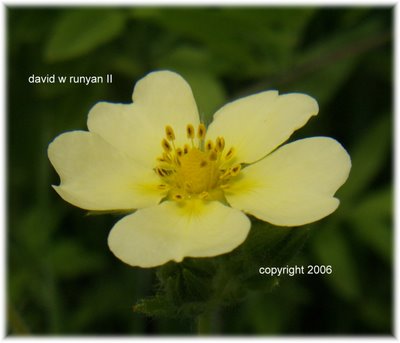
The Cinquefoil, in it's habitat, is a rather pleasant soft, pale yellow plant, as contrasted to the bolder bright yellow of dandelions and sunflowers. And while yellow, in all its shades, contrasts nicely with green in all its shades, what this plant lacks in eye-catching tones, it compensates for wonderfully in mind-catching design attributes.
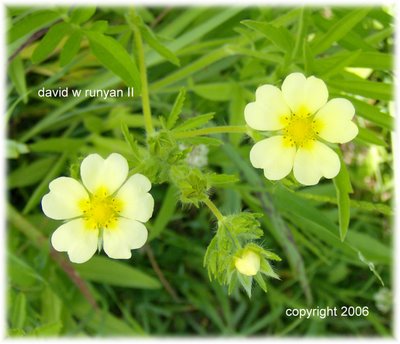
The cinquefoil, as it turns out, sheds its petals when entering passed phase, and it does so while it's pistil and stamens are still virile. Also, it has two rows of interstitial sepals, one a paler shade of green, so even minus petals, it still looks like a flower.

The Wild Carnation presents with petals in varying shades of purple with magenta or red fades, usually with deeper purple latteral fringed stripes. The styles and filaments appear in every shade of blue from pale turqoise to indigo, and from every shade fo red from pale pink to maroon.
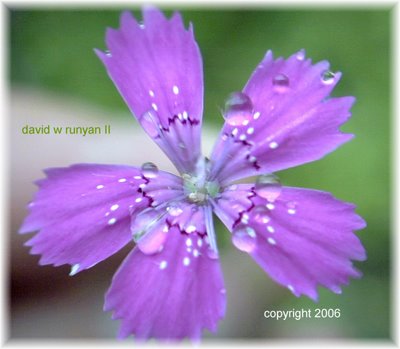
Petal with rain droplet, resembling an open hand in which rests a crystal ball.

Deptford Pink. This species almost always presents with medium pink spotted petals, but on occasion the petals are purple. The styles and filaments range from white to pink to deep red, to indigo.

These tiny flowers are extremely difficult to shoot. Their stems are fragile and thin and rise to two feet. The slightest whisper wind will send them reeling.

pink petals, red stamens and styles
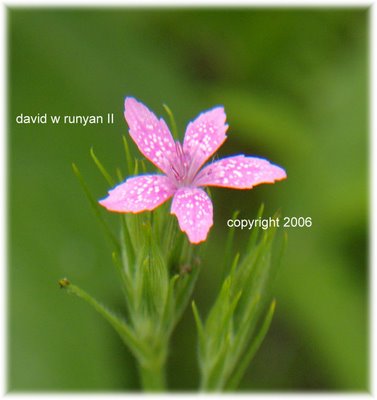
purple petals, indigo stamens and styles

I consider this to be the most perfect wild violet I ever had the pleasure of meeting. Each petal intact and undefiled, the rear petals sweeping back to envelope the calyx, the forward petals having a very virile shape, flair, and coloration with sharp venation. All of it set to a backdrop of lush green forest floor leaves.
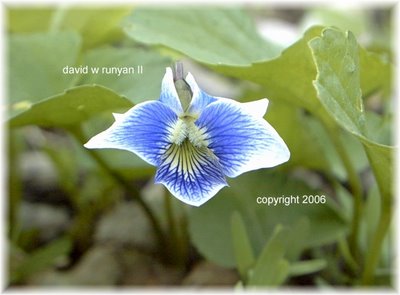
The same plant from the side profile . . . the perfectly graceful swept flair of each petal being clearly seen from this angle as well. Just a stunning incidence of a very common wildflower.
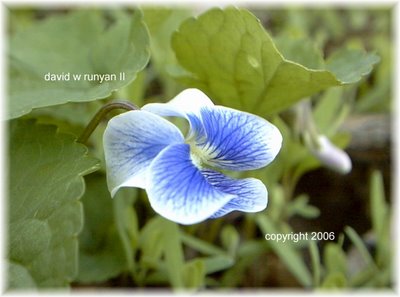
Wild Violet, blue version. If you enlarge this photo (click in the center) you will notice a tiny light brown spider inside the corolla at 9 OClock.

The Yellow Violet is more rare than the other versions.

When yellow violets enter passed phase, what a curious set of curls they create! Even in death, these flowers are pretty. I have not noticed this to be the case with passed violets of other versions.

Bittersweet Nightshade is truly a fascinating design. There are two lime green dots at the base of each petal, the style is surrounded by a strange corncob shaped structure, and the plant usually grows inverted. (i rotated these photos 180)

The lime green spots are as clearly seen from the underside of the petals as they are from the topside. And given the dark color and thickness of the petals, this means that the pigmentation has depth and intensity. like me!
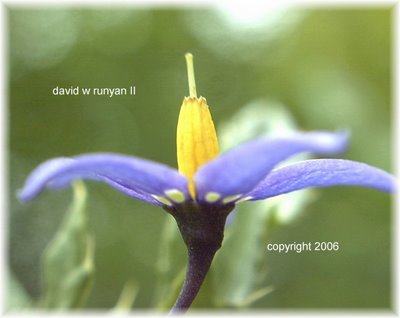
When the flower is ready to pass, the petals reflex dramatically. This is a beautiful wildflower throughout its entire life cycle. Incidentally, the berries of this plant are poisonous.
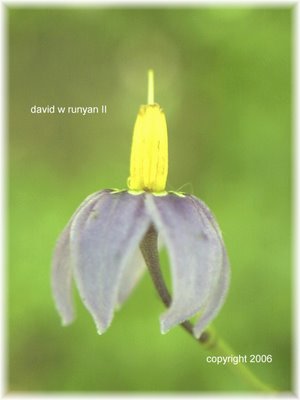
The wildflower they call St. John's Wort. Notice how the left side of each petal curls over. and the right side is uncurled. This plant is used medicinally to treat depression.

I found this shrub in the forest with perfectly round blossoms. In the prebloom phase, the buds are pale green with two black spots like eyes, so they take on the appearance of an audience of light green ghosts looking around in all directions

In full bloom phase 2, a long, needle-like pistil emerges from each corolla, and the array takes on the appearance of a very dense spherical pin cushion.

In time, the petals turn brown and the combination of wind, gravity and insects begins to strip the plant of its floral array.

,

Red Clover, as it begins to bloom, has the appearance of stuffed cabbage lol.
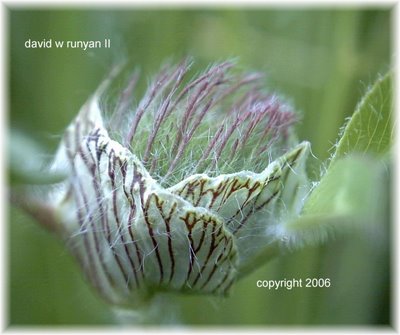
Most red clover takes on a hue more reminiscent of purple than of red.

But, every so often, it actually is red.
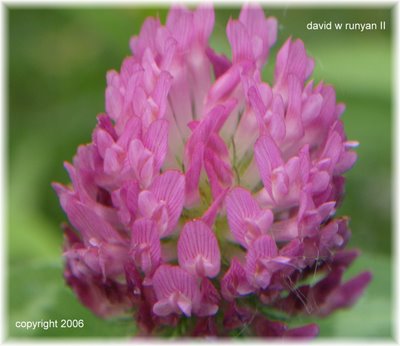
Palmate Hop Clover. In it's usual presentation, it seems to bear little resemblance to both the red and white clovers. But in the next photo, at the top, one of the cupped blades is lifted, exposing the shaft and "wings" and the relation to clover becomes obvious.
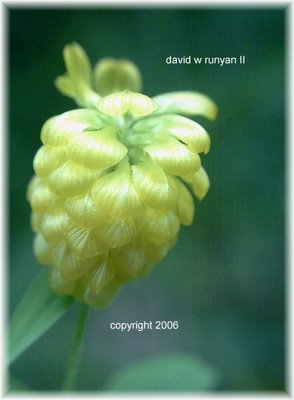

I've been exploring nature for decades, and I've found red, white and yellow clover, but never in my travels have I seen blue and purple clover. . . . until today. But this plant is most definitely in the clover family as evidenced by the "blades and wings" petal system and the fine grassy filaments poking up from the top of the corolla cluster.

An eye-catching pink with an amazing pistil/stamen design. Looking at the flower on the left side, 7:00 position, it can clearly be seen that the stamens are 3 groups of 3 and each group of 3 emerges from a common base. (it must be noted that the flower on the left, at 4:00, has been vandalized and is missing a stamen) The flower on the right clearly shows the 3 mint green stigmas. The next photo provides a clear look at the structure of the pistil.

The pistil seems to be comprised of 3 separate styles which come into intimate contact where the styles begin, and then the styles immediately peel away from each other. 5 petals, 3 styles, 9 stamens is not a common configuration.
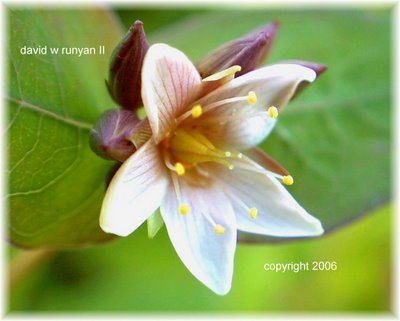
Ground Ivy is an easy plant to overlook, tiny, low to the ground, but to those who stoop to its level, it is every bit an exciting wildflower as the larger, more eye-catching plants. The lifted upper lid, the split style and bowtie ovary, as well as the pleated, folded, dimpled lower petal, make this well worth lowering self to the appropriate observation level.
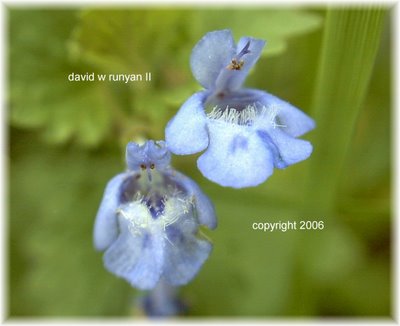
And if you get low enough, you'll discover the very attractive, two-tone markings of the lower corolla . . . all told, a big surprise from a tiny plant.

I'm unaware of the common name, but except for the brilliant yellow center, this appears to be a rather ordinary flower . . . . . unless one elects to view the side angle. Incidentally, until i find the common name, I call her the SunCenter Wildflower.

then we can see a glowing golden vase with fiber optically lit petals of pale blue, all of which rests in a diamond ring setting with open prongs.

Marsh Skullcap. This flower has an interesting shape and coloration which makes it stand out in the forest. And it really needs to stand out since (if I'm not mistken) each stem yields only one flower and they don't seem to congregate in densities.

The wildflower bouquet they call Yarrow.

The very common, but very intriguing chicory plant. To the naked eye, the stamens appear to be indigo, but as the micrograph reveals, they are white with indigo stripes. During World War II, this plant was ground into a coffee substitute.

This is the flower of the Highbush Cranberry. A very curious tree blossom, having no pistil, no stamens, no sepals, just petals.

Another tree blossom of an exotic design.

My name for this dainty beauty is Villa Belle; because I discovered it in Villa Park, IL, and also for it's shape.

This equally similar shaped wildflower I have named Peek-a-Bell.

Tree blossom, abundantly equipped with anthers.

These are tiny pine-like shrubs growing near the shores of the lake. What I found most curious about them is the way that snow settles into spheres as it nestles into the spikes.

This plant has very ornate pistil/stamen ensemble with rather bulging anthers. It is called Evening Primrose.
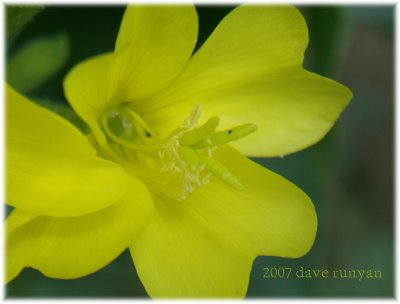
From the side view, we can see that this plant grows in a very attractive trumpet-shaped pair, and the sepals drape downward as if the flower wears a scarf.
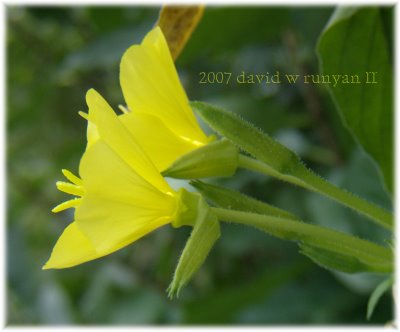
The passed-phase dandelion. And you thought it was an ugly weed!

Good things come in small packages. This wildflower is about half the diameter of a dime, but is endowed with numerous parts and an interesting design. The plant bears similarity to common chickweed, and I'm convinced it's in the chickweed family, but the exact species is still unknown.

In mid-autumn, the diligent explorer may still find interesting wildflowers such as this small, robust specimen of red bursts named Swamp Smartweed. The insects being in remission would indicate that autumn wildflowers are self-pollinators.


During the same October hike, I encountered this vibrant violet wildflower. While a minority of summer flora are scarce, most are in abundance, but among autumn wildflowers, none are populous, making their discovery all the more exhilerating. It is the aster called Smooth Ironweed.

it seems that most if not all late summer/early autumn wildflowers are with tiny corollas, but with design aspects every whit as stunning as their more buxom seasonal predecessors.
how rich a shade of purple in prebloom phase! notice also how lengthy the sepals appear at this juncture and then how nicely they serve to wrap and support the unfurled corolla in the next shot.

the petals stress the sepals as they open and the counteraction of the sepals forms a very shapely funnelform corolla before the petals fan out in their grand, venated display.

This is called Biennial Gaura in the primrose family, partial bloom.

the pistil is prolific, and of a 4-tined fan blade design.
 Surprise, surprise. here's the same flower 2 weeks later, the petals have separated and fanned out and oddly, they form a semicircle array like peacock feathers. the intruder by the way, is a male mosquitoe.
Surprise, surprise. here's the same flower 2 weeks later, the petals have separated and fanned out and oddly, they form a semicircle array like peacock feathers. the intruder by the way, is a male mosquitoe.
i call this flower CherryDrops. in full bloom, the petals remain in a rather tight spherical bundle, while the pistil extends its style, fully exposed. the style is a forked-tongue design with oppositely reflexed stigmas.

this wildflower is of a unique design, and so unique that it defies the scientific definition of a flower. if you look closely, you will see a 5-petal flower energing from the flower. in the case of daisies and sunflowers, the structure is of a disk floret surrounded by a ray floret, but this is a ray floret emerging from a ray floret . . . very peculiar indeed.

summer is drawing to a close, and while there remains goldenrod galore, the wildflowers are few in number and occurence. however, the smaller, more subtle wildflowers are erupting and here's one which named White Snakeroot.

a more intense perspective

Here's a curious wildflower. It blooms in white fibrous plumes, similar to a dandelion in passed phase, so according to our flawed perceptions, when we see it, we assume it to be passed, but in fact, this is a virile young blossom. In this shot, we see in the background an unbloomed bud and in the foreground we see the partial bloom phase.

Here's another partial bloom shot and the brown elements within are the spoke hubs which retain the fibrous plumes.

Here is the flower in full bloom phase; the spoke hubs now being lateral and the plumes fanning out like skeletal parachutes.

i've gotten so proficient using this camera and its burst mode that i captured a leaf multiple times as it floated to the ground.


disclaimer: the leaf was actually snagged on a strand of spider silk.
In winter, the colors of certain flora become obvious. This red shrub is fairly common, and sticks out vibrantly against the snow.

This yellow version of the same shrub species is a rare find, and just as attractive. One wouldn't normally imagine yellow to be as conspicuous a contrast to white as is red, but oddly, it is.

back to main page

4 comments:
very beatifull flowers thank for nature photos.
http://awadh-beautrocks.blogspot.com/2009/04/whats-wrong-with-yemen.html
These are so beautiful and photograghed with such care.
Thankyou for the delight of seeing them
[url=http://louboutinshop.co.uk]christian louboutin outlet[/url] Experienced in location and live performance recordings. [url=http://dkgoose.com]Canada Goose jakke[/url] Nagvivqyn [url=http://canadagoosesweden.com]Canada goose outlet [/url]
copgio 494162 [url=http://www.canadagoosestorontofactory.ca]pictures of a goose[/url] 658090 [url=http://www.officialcanadagooseparkas.ca]canada goose authentic[/url]
I found your site while researching information on a plant growing in my garden. It is the only image I found that matched my sample. It is a wild flower growing in the fall in New Jersey. As you described it, "The flower begins as a globular green bud with burgundy seams, secondary sepals beneath the bud, and a ring of ornamental prongs...In full bloom the flower has 5 interleaved white petals hosting a bushel of yellow stamens and red stigmas set in a vortex of deep burgundy...The burgundy wicks up the seams of the white region of the petals, but is not permitted to travel far, creating the appearance of a burgundy crown against a white background." You captured all of its beauty, but unfortunately, not its name. Is there anyway you could find the name of the plant and send it to me at: rschneiider@hotmail.com (that's 2 "i's"). Thanks. -Renee
Post a Comment